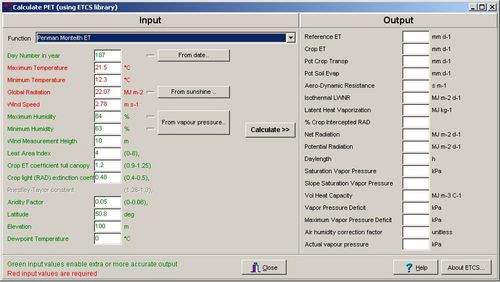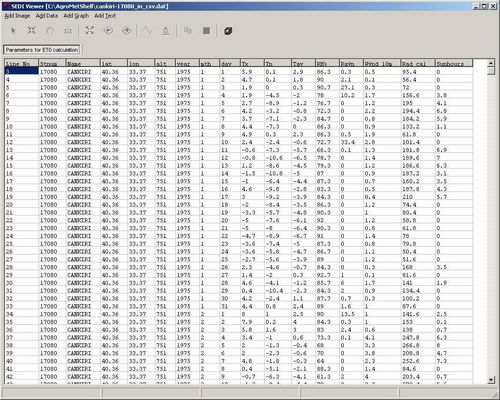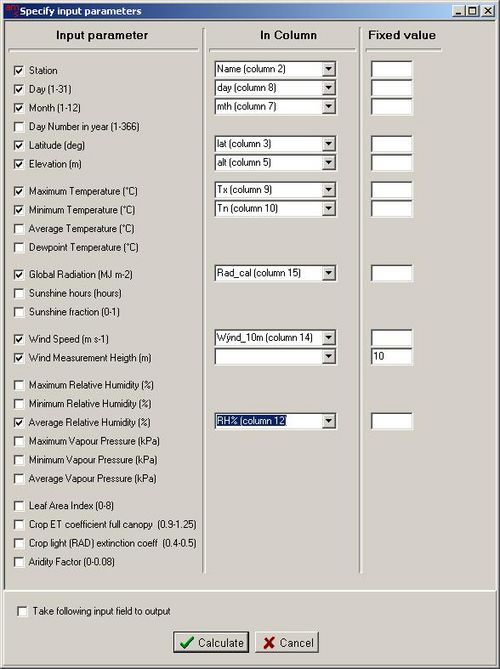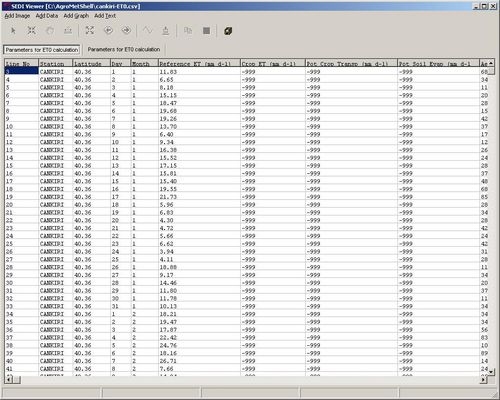[edit]3.2. Computing the reference evapotranspiration ET0.
Peter Hoefsloot Since 1972, FAO has used the modified Penman method to estimate the evapotranspiration of a reference crop (Frere and Popov, 1986). Recent comparative studies have however shown the best-performing combination equation of the Penman-Monteith approach which has been adopted by FAO in the methodologies for estimating the crop water requirements. The reference evapotranspiration ETo is defined as the rate of evapotranspiration from a hypothetical crop of 12 cm height, with canopy resistance of 69 [s m-1] and a canopy reflection coefficient (albedo) of 0,23.
Potential evapotranspiration (ET0) is a vital input to Water Balance calculations, which in turn is a vital part in Crop Forecasting. The parameters needed to calculate ET0 are listed below. The data should be provided in daily form. This will result in daily ET0 values that have to be aggregated to dekads.
Parameter group Parameters Remarks Temperature Maximum and minimum temperature Some ET0 calculation methods use average temperature only. AgrometShell needs both minimum and maximum temperatures. Radiation (MJ/m2) Global radiation Global radiation can be calculated from sunshine hours or sunshine fraction accompanied by latitude and day in the year (Julian Date). Wind Speed (m/sec) Wind speed at 2 meters Formulas are available to convert wind speed for other heights (e.g. 10 meters) into 2 meter values. Optional: relative humidity (%) Maximum and minimum relative humidity during the day. Although this parameter is not essential it improves the ET0 calculations substantially. In AgrometShell relative humidity can be calculated from vapour pressure measurements. The ET calculation routine incorporated in AgrometShell have been developed by Dr. Marcello Donatelli (http://www.sipeaa.it/mdon/). He publishes a number of his agrometorology methods on the web (for on-line ET calculation examples see: http://www.sipeaa.it/wfet/).
[edit]Checking data availability using AgrometShell
In order to check whether enough input data are available to calculate ET0 AgrometShell is used. In AgrometShell activate the Tools – Potential ET – Manual function.
[edit]Calculating ET0 using external ASCII files.
The ET0 calculations can be performed in AgrometShell using data from the database or data in external ASCII files. In this paragraph the second option will be outlined.
After calculating the ET0 values need to be imported into AgrometShell using the procedure on ASCII import.
Subsequently, the data are aggregated from daily to dekadal values using then function Database-Calculate-Actual-Monthly from dekadal from daily.

| CM Box User Guide | Main Page | About | Special pages | Log in |
Printable version | Disclaimer | Privacy policy |





